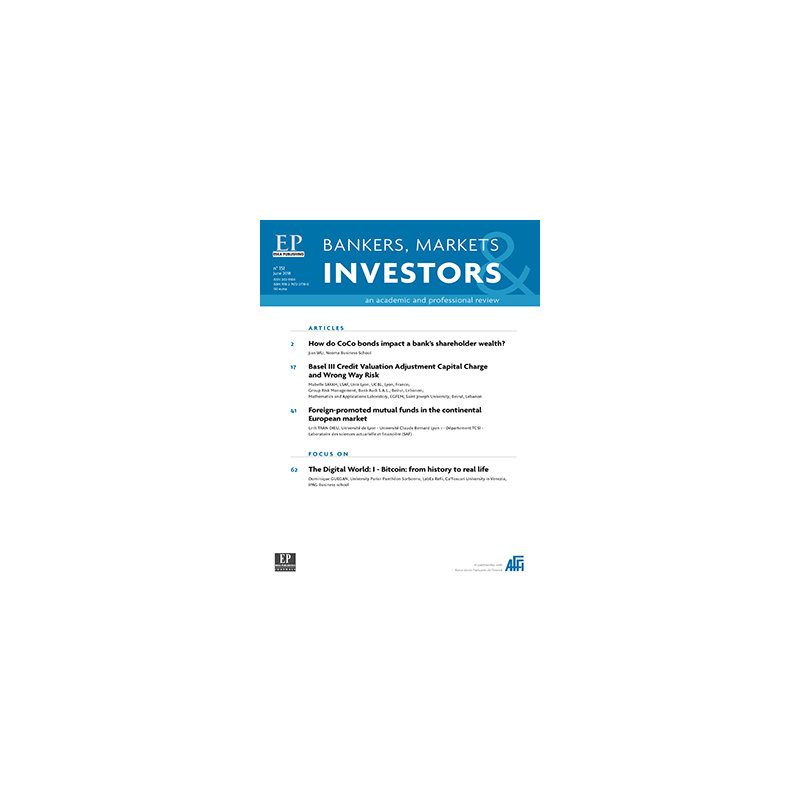



 POUR COMMANDER
POUR COMMANDER
Contactez les Editions ESKA - par téléphone 0142865565 - par mail congres@eska.fr
 CGV
CGV
Consultez nos Conditions Générales de Vente
Jian WU, Neoma Business School
The 2008 crisis highlighted the fragility of the banking system. To address this defciency, the Basel committee agreed on the Basel III Accord to strengthen banks’ capital requirements. However, raising additional common equity funds is costly. Faced
with this problem, banks and regulators wonder whether capital can be raised less
expensively. To this end, Contingent Convertible (CoCo) bonds have been designed
to absorb banks’ losses in times of crisis. Might CoCo securities be an effctive prevention and/or rescue solution? This article examines the impact of Debt-to-Equity
CoCo bonds on a bank’s capital structure. For the fist time, leverage ratios based on
non-risk-weighted-assets (NRWA) are used as equity conversion triggers instead of
traditional capital ratios based on risk-weighted-assets (RWA). We fid that CoCo
bonds generally increase shareholder wealth by reducing their bankruptcy risk, except when the dilution effct offets this positive effct. By boosting banks’ capacity
to absorb losses while giving regulators more time to fid a rescue solution, CoCo
bonds strengthen fiancial stability. We also highlight the importance of defiing
diffrent variables and parameters properly when designing CoCo bonds. When
these variables and parameters are appropriately chosen, CoCo bonds are able to
fulfi their function as “going-concern” capital, while bank shareholders are capable
of maximizing their wealth.
JEL Codes: G21, G13, G19.
Keywords: Banks’ regulatory capital requirement, Basel III, Contingent Convertible (CoCo)
bonds, Shareholder wealth, Option pricing, Barrier options.
Mabelle SAYAH, LSAF, Univ Lyon, UCBL, Lyon, France;
Group Risk Management, Bank Audi S.A.L., Beirut, Lebanon;
Mathematics and Applications Laboratory, EGFEM, Saint Joseph
University, Beirut, Lebanon
As part of a very dynamic fiancial environment, regulations are always being improved
and enhanced in order to keep the fiancial markets as transparent and regulated as
possible. Basel is currently shifting towards central clearing of derivatives products
and amending a capital charge, Credit Valuation Adjustment (CVA) capital charge, for
those that are not cleared through Central Counterparty Clearing Houses. In this work,
a fist part explains the newly proposed approaches for computing the regulatory CVA
capital requirement. Afterwards, the importance of incorporating the Wrong Way Risk
(WWR) in the computation of the CVA is detailed. An approach based on Error Correction Models highlights the diffring impact of such risk for several counterparties.
Applications on interest rate swaps with a single investment grade sovereign counterparty are considered. A fist conclusion discusses the divergence between the two
regulatory approaches when dealing with diffrent counterparties within the same
risk bucket. In addition, another result is interpreted following the ECM methods reflcting the changing impact of the WWR for the counterparties considered: even for
the three European investment grade sovereigns, the model reflcted a higher WWR
for Spain than the one observed for Ireland or France. A proposed modifid scale for
Basel methodologies would account for the effctive credit quality and WWR of each
specifi counterparty in a way that converges the requested charge under both possible regulatory capital charge methodologies.
JEL Codes: C53, G17 et G32.
Keywords: CVA, WWR, ECM, Basel III, BA-CVA, FRTB SA-CVA
Linh TRAN DIEU, Université de Lyon - Université Claude Bernard
Lyon 1 - Département TCSI - Laboratoire des sciences actuarielle
et fiancière (SAF)
Although European market regulators have implemented many measures in order to
make the market more integrated, a recent report by the European Fund and Asset
Management Association (EFAMA) in 2015 underlines that domestic actors remain
principal participants in member countries. My research questions the integration of
the European market by investigating the place of foreign promoters in continental
European markets. Using 12315 equity funds from 14 continental European countries
for the period from 2002 to 2014, I analyze the competitiveness and the market shares
of foreign-promoted funds. The results show that foreign-promoted funds seem to
be better performing than domestic-promoted funds. However, they do not attract
more investors. Foreign promoters appear to have signifiantly smaller market shares.
These results highlight the existence of barriers to foreign promoters in the European
mutual fund market.
JEL Codes: G00, G10, G11, G28, G30.
Keywords: Mutual funds, Foreign promoters, Market shares of foreign promoters,
Competitiveness of funds.
Dominique GUEGAN, University Paris1 Panthéon Sorbonne, LabEx ReFi;
Ca’Foscari University in Venezia, IPAG Business school
Bitcoin can be considered as a medium exchange restricted to online markets, it is not a
unit of account and a store of value, and thus cannot be considered as a money. Bitcoin
value is very volatile and traded for diffrent prices in diffrent exchanges platforms,
and thus can be used for arbitrage purpose. His behavior can be associated with a
high volatile stock, and most transactions in Bicoin are aimed to speculative instruments. The high volatility in Bitcoin and the occurrence of speculative bubble depend
on positive sentiment and confience about Bitcoin market: several variables my be
considered as indicators (volume of transactions, number of transactions, number of
Google research, wikipedia requests). The star of the crypto-currencies has attained
the 19 716 dollars in December 2017 and decreased to 6707 dollars March 29, 2018. In
capitalization is at this time the 30th mondial currency. We explain some limits and
interests of the Bitcoin system and why the central bankers and regulators need to
take some decision on its existence, and in a second paper we suggest what could be
the possible evolution of the Bitcoin Blockchain.
JEL Codes:E4, E5, L5.
Keywords: Bitcoin, Blockchain, Cryptocurrency, Regulation